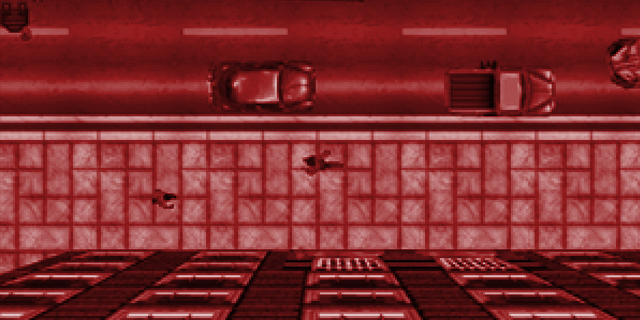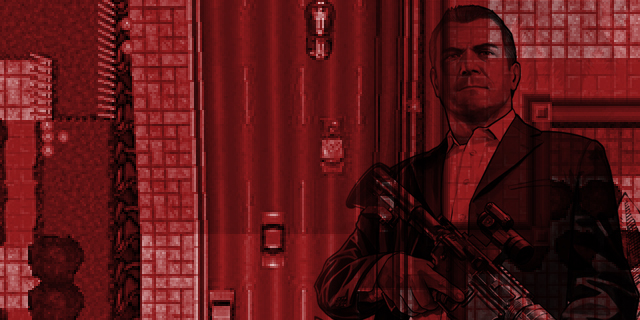
In From Pixels to Polygons, we examine classic game franchises that have survived the long transition from the 8- or 16-bit era to the current console generation.
From its cult following beginnings to its mainstream blockbuster success, the Grand Theft Auto series has always pushed boundaries. Today, we explore the evolution of the controversial series.
Turning to a life of crime
 Grand Theft Auto was one of the first open-world games to attempt a real world location. The entirety of the first game is shown in a top-down perspective. With no interior locations and no cutscenes, the missions are simply a way to earn money, a mechanic that gates progress through levels. Missions are given through payphones, and usually involve simply driving or shooting. Most of the core mechanics of GTA began here, including causing random chaos and seeing how long you can last. There wasn’t much side stuff in the game, though you could sell cars to a ship in the port, no questions asked. You had access to all three cities, each with two scenarios, though they’re rather small by today’s standards. Grand Theft Auto became a bit of a cult classic because it wasn’t like any other game available at the time, despite its somewhat-shallow gameplay.
Grand Theft Auto was one of the first open-world games to attempt a real world location. The entirety of the first game is shown in a top-down perspective. With no interior locations and no cutscenes, the missions are simply a way to earn money, a mechanic that gates progress through levels. Missions are given through payphones, and usually involve simply driving or shooting. Most of the core mechanics of GTA began here, including causing random chaos and seeing how long you can last. There wasn’t much side stuff in the game, though you could sell cars to a ship in the port, no questions asked. You had access to all three cities, each with two scenarios, though they’re rather small by today’s standards. Grand Theft Auto became a bit of a cult classic because it wasn’t like any other game available at the time, despite its somewhat-shallow gameplay.
Grand Theft Auto 2 moved the series to a polygonal engine. The game was still top-down, but the world and buildings had depth. Interior areas were added seamlessly, with the roof disappearing when you entered a structure. All of the usual mechanics were present, but the three cities disappeared. Instead, the game took place in an unnamed city, with three areas: commercial, residential and industrial. Each area featured its own set of gangs. The player could undertake missions from each gang, but working for one often put you at odds with another, so a balance was required. If one gang got angry enough, the player would be attacked on sight. Killing gang members altered this balance, offering a way to improve relations. GTA 2 didn’t feature a huge amount of narrative; the goal was to amass a high enough score to unlock the next area. – Jeff deSolla
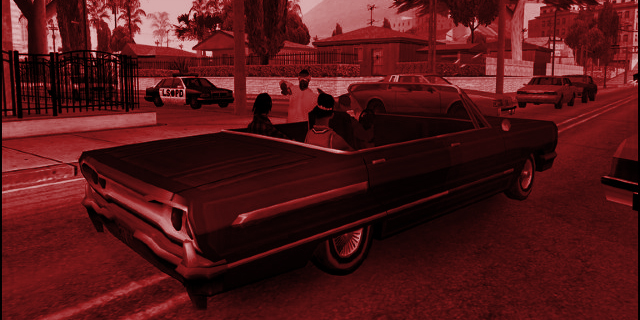
From misdemeanors to felonies
 Grand Theft Auto III introduced a fully-3D world, creating what would become the modern sandbox genre. While there was a story attached to the game, you were free to explore this world, do side quests or even just mess around with the residents of Liberty City and get in trouble with the police. While the game would garner a lot of praise for its ambitious gameplay and great narrative, the series would infamously be known for all the crimes you would be able to commit throughout the game, such as picking up prostitutes, carjacking pedestrians and killing civilians and police officers.
Grand Theft Auto III introduced a fully-3D world, creating what would become the modern sandbox genre. While there was a story attached to the game, you were free to explore this world, do side quests or even just mess around with the residents of Liberty City and get in trouble with the police. While the game would garner a lot of praise for its ambitious gameplay and great narrative, the series would infamously be known for all the crimes you would be able to commit throughout the game, such as picking up prostitutes, carjacking pedestrians and killing civilians and police officers.
Starting with GTA III, Rockstar managed to secure music licenses for the in-game radio stations. Complete with DJs striking up conversation with the listeners, as well as a huge array of music that accommodates to different tastes among the game’s various stations, the music would add ambience to the game and even add a little insight into its world.
Vice City would follow up the popular game a year later. Set in ’80s Miami, the game follows Tommy Vercetti and his eventual rise through the city’s crime ring. The addition of property purchases added a bit of depth in-game. These included safe houses, a film studio, a strip club and a boatyard. There were missions attached to these locations that would help further Tommy’s status in the city. The ’80s theme found its way through the radio stations, the cars and the fashion of the main characters and civilians.
San Andreas, released in 2004, follows Carl Johnson, who finds himself returning to his gang life in LA-based Los Santos in the early ’90s. We follow his adventure of losing it all and rising to power amongst the rival gangs. The game allows CJ to grow as a character. You’re able to customize his skills with various vehicles, as well as change his appearance. San Andreas‘ map was almost four times the size of Vice City, and was packed with gang-related side quests, basketball, dancing, arcade machines and gambling. – Eric Albuen
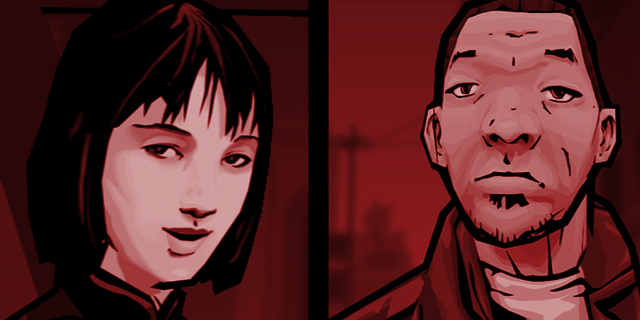
Fleeing the scene of the crime
 Two side games, Liberty City Stories and Vice City Stories, made an appearance on the PSP in 2005 and 2006, and later found their way to the PS2. Based in the worlds of GTA III and Vice City, they revisited locations of those games with new characters and protagonists. While there was nothing revolutionary about the gameplay or story, the addition of an ad-hoc multiplayer mode would set the stage for changes to come.
Two side games, Liberty City Stories and Vice City Stories, made an appearance on the PSP in 2005 and 2006, and later found their way to the PS2. Based in the worlds of GTA III and Vice City, they revisited locations of those games with new characters and protagonists. While there was nothing revolutionary about the gameplay or story, the addition of an ad-hoc multiplayer mode would set the stage for changes to come.
Chinatown Wars was a distinctly different game than the rest. Returning to the original top-down style, it follows the story of Huang Lee, the son of a recently-deceased Triad boss. Set in the GTA IV version of Liberty City, the game features a lot of aesthetic changes featured in the console game, such as the simplified HUD. Selling various illegal substances was introduced as an additional way to earn money. The game also make use of the Rockstar Games Social Club to share in-game information and upload gameplay statistics, as well as additional missions. While the DS and iOS versions make use of touch controls for the tattooing mini-game and carjacking, they’re turned into quick-time events in the PSP version. – Eric Albuen
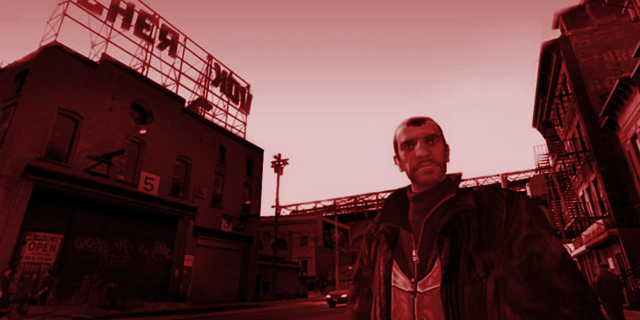
Building and maintaining an empire
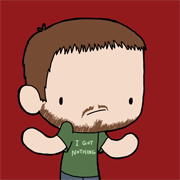 Grand Theft Auto III and the two games that followed made sandbox games cool, but by the time Rockstar was ready to release the next game in its hugely-successful franchise, the landscape had changed drastically. When GTA IV was released on the 360, it was beaten to the punch by a small studio named Volition and the first game in the now-ridiculous Saints Row series. Despite the many imitators vying for Rockstar’s crown, there was no denying that GTA was still a force to be reckoned with. IV may not have shaken up the medium the same way its predecessors did, but it offered more polish than expected. It introduced you to the cell phone, an invaluable (and some would say annoying) tool that gave you easy access to side activities, your growing list of friends and a bevy of other handy functionality, making your life in Liberty City that much easier. The story was more focused and (despite some ridiculousness) grounded, complete with the series’ most memorable cast of characters to date.
Grand Theft Auto III and the two games that followed made sandbox games cool, but by the time Rockstar was ready to release the next game in its hugely-successful franchise, the landscape had changed drastically. When GTA IV was released on the 360, it was beaten to the punch by a small studio named Volition and the first game in the now-ridiculous Saints Row series. Despite the many imitators vying for Rockstar’s crown, there was no denying that GTA was still a force to be reckoned with. IV may not have shaken up the medium the same way its predecessors did, but it offered more polish than expected. It introduced you to the cell phone, an invaluable (and some would say annoying) tool that gave you easy access to side activities, your growing list of friends and a bevy of other handy functionality, making your life in Liberty City that much easier. The story was more focused and (despite some ridiculousness) grounded, complete with the series’ most memorable cast of characters to date.
While it didn’t do a lot to change things up completely, it was the first game in the series to add multiplayer. GTA IV’s online functionality included a host of different game options that took you around Liberty City. The game’s free mode, which essentially allowed you to run around with a group of friends and cause havoc, became a multiplayer standby.
The newly-released Grand Theft Auto V focuses on expanding these ideas. The big change is the addition of multiple protagonists, giving you plenty of opportunities to swap between them on the fly. This is useful for jumping around the city whenever possible, but each protagonist has his own stats, making it easier to rely on certain characters for specific missions or side activities. This also marks a return of the RPG-esque elements from San Andreas, rewarding you for doing certain actions with each character instead of making it feel more like busy work. There are also the heist missions, which are new to the series and transform the experience from “just another Grand Theft Auto” into something more complex and satisfying. It’s an expansive game, but one that feels like the culmination of everything the series has been moving toward. – Andrew Passafiume
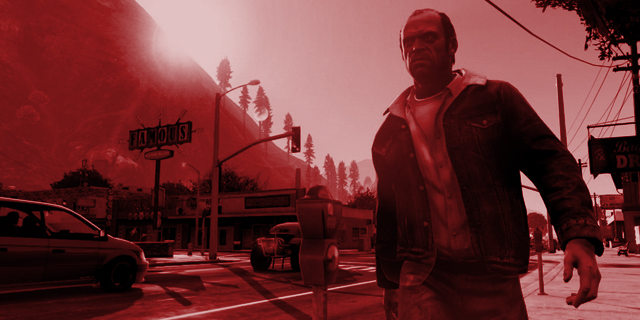
What’s the peak of the Grand Theft Auto series?
 Jeff: If San Andreas represented the old high-water mark, and capped off its generation, Grand Theft Auto V has raised the bar even higher on the current set of consoles. I was skeptical at first, but GTA V has shown that Rockstar remains a master of the open-world game.
Jeff: If San Andreas represented the old high-water mark, and capped off its generation, Grand Theft Auto V has raised the bar even higher on the current set of consoles. I was skeptical at first, but GTA V has shown that Rockstar remains a master of the open-world game.
 Eric: I have a soft spot for Vice City. My love for ’80s music and the fact the map was just the right size made this one of my favorites. However, it’s hard to deny that Grand Theft Auto V is currently up on top. The huge world map, the deep narrative and all the visual improvements easily make this the best.
Eric: I have a soft spot for Vice City. My love for ’80s music and the fact the map was just the right size made this one of my favorites. However, it’s hard to deny that Grand Theft Auto V is currently up on top. The huge world map, the deep narrative and all the visual improvements easily make this the best.
 Andrew: As much as I love Grand Theft Auto IV, the recent release of Grand Theft Auto V makes a compelling argument for being the height of the ever-expanding GTA series. It almost feels like there is no real way to improve from here, but knowing Rockstar, there will always be opportunities to expand the formula in exciting ways.
Andrew: As much as I love Grand Theft Auto IV, the recent release of Grand Theft Auto V makes a compelling argument for being the height of the ever-expanding GTA series. It almost feels like there is no real way to improve from here, but knowing Rockstar, there will always be opportunities to expand the formula in exciting ways.
In our next installment, we put our urban planning skills to the test with a look at SimCity. For more, check out the archive.



